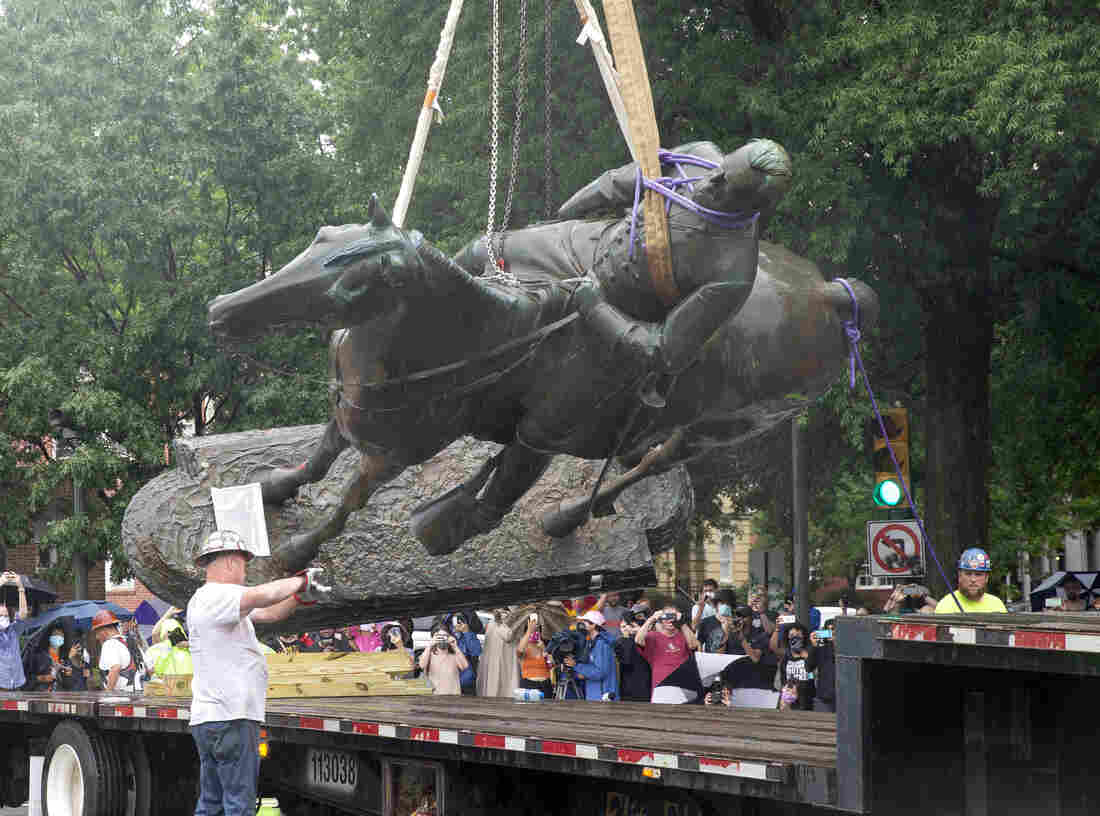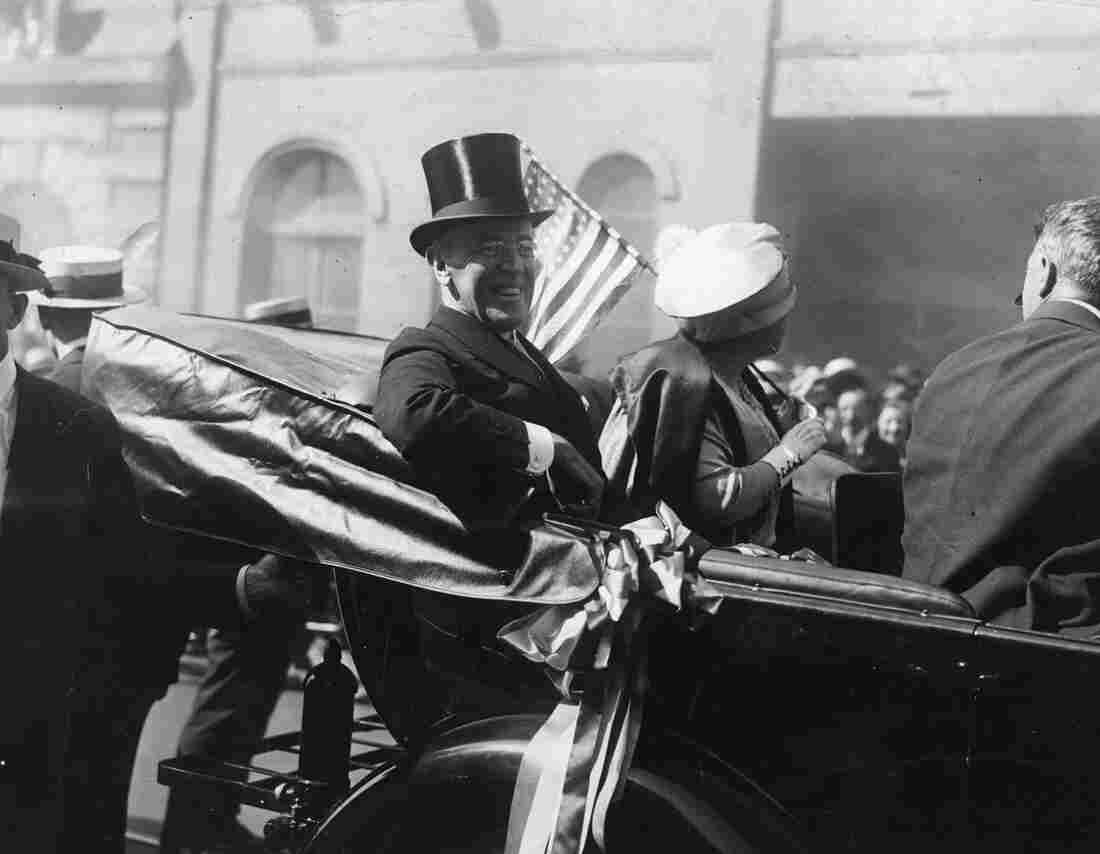
A Stonewall Jackson statue is loaded on a truck after being removed from Monument Avenue in Richmond, Va., on Wednesday. Ryan M. Kelly/AFP via Getty Images hide caption
In Richmond, Va., the former capital of the Confederacy, a bronze statue of Confederate general Stonewall Jackson sitting triumphantly astride his horse, Little Sorrel, no longer towers above that city's Monument Avenue.
To the cheers of a crowd of onlookers who gathered in the pouring rain earlier this week, work crews cut the statue from its granite base, and after hours of labor, a crane lifted it away to be put in storage, at least temporarily.
Jackson's dethroning came on orders from Richmond Mayor Levar Stoney, who claimed emergency powers to act in the interest of public safety. "We've had 33 days of unrest," Stoney told NPR. "It's time to move beyond the lost cause and embrace the righteous cause. We can be more than just the capital of the Confederacy. It's time for us to be the capital of compassion."
The removal of the Stonewall Jackson memorial is emblematic of a nationwide reckoning with race that has re-energized debates over which historical figures we honor and how.
The scrutiny goes well beyond monuments to the Confederacy. Among those whose legacies are coming under sharp review is Woodrow Wilson, the 28th president of the U.S., who served from 1913-21.
Wilson was the leading architect behind the League of Nations after World War I. His efforts won him the Nobel Peace Prize. His name is bestowed on boulevards, bridges, schools, and even a rest stop along the New Jersey Turnpike.

President Woodrow Wilson and first lady Edith Wilson ride in a carriage in New York. Hulton Archive/Getty Images hide caption
'He hurt black people'
But Wilson also resegregated the federal government. He screened the racist film Birth of a Nation at the White House, and called Blacks "an ignorant and inferior race."
At a recent rally in Washington, D.C., 18-year-old Anna Parra-Jordan, a newly-graduated student of the city's Woodrow Wilson High School, was among those passionately calling for Wilson's name to be scrubbed from the school.
"His legacy is racism!" she told the applauding crowd. "He hurt black people. And when you hurt black people, nothing else that you do matters!"
Nearly 2,000 people have signed a petition urging the school system to change the school's name, and D.C. Mayor Muriel Bowser says she supports the move.
In June, after years of debate, the board of trustees of Princeton University, where Wilson served as president from 1902-10, voted to remove his name from its prestigious School of Public and International Affairs, as well as a residential college, citing what the trustees called Wilson's "racist thinking and policies."
'Your name is a pronouncement of your values'
If you're a school whose name is entwined with the Confederacy, that raises even deeper questions about your core identity.
"Your name, whether you're Coca Cola or Google or Washington and Lee, is a pronouncement of your values," says James Casey, economics professor at Washington and Lee University in Lexington, Va., where Robert E. Lee served as college president immediately after the Civil War.
Casey is spearheading a movement among faculty, asking the university to shed Lee's name and to dissociate from the Confederacy and all it stood for.
"Keeping the name is not neutral," Casey says. "It is sending a message. And in the context today it does just seem to me, are we going to wait until everyone else has done this, or will we be part of the movement, or will we lead? And I think it's already too late for us to lead. I think we've already lost that ground."
But where do you stop? If you drop Lee, what about Washington, who owned hundreds of slaves himself?
Casey says of course, Washington's legacy is problematic. But he agrees with those who draw this line: Washington was a founding father. Lee was a traitor to his country.
"Lee took an oath to the Constitution," Casey says, "and he betrayed that oath to the Constitution of the United States for one reason and one reason only: to protect the institution of slavery."
In Boston, the debate over historic representation has focused lately on two figures cast in bronze: the Emancipation Memorial. It's a copy of the original statue in Washington, D.C., which was erected in 1876 and is also known as the Freedman's Memorial. Both have been the target of protests.

Boston officials have decided to remove the Emancipation Memorial, which has stood in Park Square since 1879. It depicts a formerly enslaved man kneeling before Abraham Lincoln. Jesse Costa/WBUR hide caption
Wrestling with interpretation of memorial story
The memorial, designed and sculpted by Thomas Ball, shows Abraham Lincoln with one arm outstretched, his other hand holding the Emancipation Proclamation. Lincoln is looking down at a freed Black man who is kneeling at his feet, with a loincloth draped around his waist and broken shackles around his wrists. The inscription on the pedestal in Boston reads, "A race set free / and the country at peace / Lincoln / Rests from his labors."
For critics like Boston-area actor and activist Tory Bullock, who launched a social media campaign to have the statue removed, the message sent by that crouching emancipated man is demeaning. "If he's free," Bullock asked, "why is he still on his knees?"
To Bullock's exultation, that campaign worked. After nearly two hours of public comment, Boston's art commission voted unanimously to take the memorial down. "What I heard today is that it hurts to look at this piece," said commission vice chairperson Ekua Holmes, "and in the Boston landscape, we should not have works that bring shame to any groups of people."
But defenders of the memorial point out that the original work in Washington, D.C., was paid for with funds donated by freed slaves, and that when the D.C. statue was dedicated in 1876, before an audience that included President Ulysses S. Grant, Frederick Douglass delivered what is considered one of the great speeches in American history.
"I actually don't think it should be taken down," says poet and scholar Elizabeth Alexander, president of the Andrew W. Mellon Foundation.
Alexander grew up in the Washington, D.C., neighborhood where the original stands. She recalls seeing this statue all the time and learning the context surrounding it from her mother, historian Adele Logan Alexander.
Over the years, she has wrestled with how to interpret the story the memorial is telling. "Was that slave rising of his own accord?" Alexander asks. "Was he claiming his own freedom? Was he being put down? Was Lincoln being lifted up as the great white savior, when really the end of slavery was a more complicated affair?"
All history is revisionist history
Alexander proposes an alternative to taking the memorial down: erecting a companion statue of Frederick Douglass nearby. After all, she says, these memorials offer a chance to contextualize and learn.
"Every day I think about the opportunities," she says. "Historians have a little joke where they say all history is revisionist history. You know, history is always responding to the history that was written before it."
Which means, Alexander says, that this moment gives us the chance to ask crucial questions: What kind of democracy are we? And who did build the country?
"We are revisiting the sacred cows," Alexander says. "We're taking a moment to say, we don't value this. And in fact, valuing this has in part led us to a place where our society is profoundly, profoundly fractured."
Now, she says, as more monuments come down, the question is, what will we put in their place?
"how" - Google News
July 03, 2020 at 04:02PM
https://ift.tt/3dWjijJ
Revisiting Sacred Cows: Which Figures From History Do We Honor, And How? - NPR
"how" - Google News
https://ift.tt/2MfXd3I
Bagikan Berita Ini














0 Response to "Revisiting Sacred Cows: Which Figures From History Do We Honor, And How? - NPR"
Post a Comment